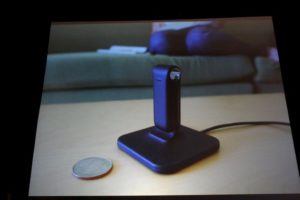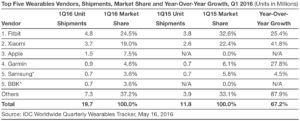FitBit: Say You Want a (New Year’s) Resolution

Are wearables the IoT version of the Master Cleanse? Or can they really stick? It is still early days but whether you actually kept your New Year’s Resolution won’t be a determining factor. Ask your CEO instead.
Glorified pedometers. Ugly jewelry. An overpriced tech fad. Nike’s latest failure[1]. There were a lot of monickers thrown around to describe the latest fitness tracking devices. Despite the many non-believers, these small bands that fit around your wrist were the beginning of a much bigger health and connected device revolution.
The Beginning
Founded in 2007, FitBit was one of the early adopters of this wave of devices. But leading the charge wasn’t easy. The early FitBit only tracked an individual’s steps and looked more like a bulky tie clip (see below). There was also a large margin for error, with something as light as turning a page (while still sitting down!) triggering the recording of a step.[2] By 2014, FitBit faced a class action lawsuit when some users experienced skin rashes after wearing the new bracelet version.[3]
Despite some of these earlier setbacks, FitBit continued to innovate. It moved into social, allowing users to compete with each other via “challenges” or competitions. It also expanded its offerings, adding additional features such as specific activities (running, biking, skiing etc.), Bluetooth for data transfer and the recording of sleep and food. Today, the latest versions include automatic uploads to the app, insights based on user behavior and heart rate monitoring for even deeper health insights. In 2015, the company sold over 21 million devices across 29 million registered users and has the largest market share in wearables.[4]
Evolving Model
However, one of the biggest changes came not from the features, but from FitBit’s business model. Despite Nike’s exit from the wearables space, competitors such as Misfit Wearables and Xiaomi started to saturate the consumer market with lower end models and Jawbone occupied the same range as FitBit. In this type of environment, in June 2015, FitBit IPOed.[5] With the new infusion of capital and sold out collections with fashion partners such as Tory Burch, FitBit started to gain a lead on Jawbone.[6] And then FitBit started to focus on the corporate segment instead, pushing devices to companies, while maintaining its foothold in the consumer segment.
The corporate wellness market is worth $7.8 billion with 15.9% of that dedicated exclusively to fitness services.[7] Recognizing the opportunity there, FitBit has since partnered with nearly 70 companies and continues to seek new opportunities to complement corporate wellness programs.[8]
Vision Going Forward
From its current position, FitBit has two potential avenues for future growth. The company can either position itself as a center for a connected home or it can deepen its corporate relationships further and potentially start to penetrate the healthcare sector.
Being at the center of the connected home seems like a lucrative position as it would make FitBit an indispensable part of the whole ecosystem. Given it is the current leader of wearables vendors worldwide, making FitBit an integral part of the IoT home seems like a great value proposition for all parties.[9]
However, this position does not seem sustainable: Xiaomi and Apple are gaining on FitBit and it has lost over 8% market share in just one year, despite overall company growth. In light of that, it appears that moving forward with corporate partners and becoming deeply ingrained there via contracts and large spending programs, could be the best strategic move.
As of 2016, FitBit represented nearly 70% of all devices used in corporate wellness programs which includes names such as Barclays and Target.[10] Even here though, competitors – especially ones with pockets as deep as Apple’s – have and will continue to close the gap. These corporate partnerships are helping to secure FtiBit’s position in the market but one additional step to consider is taking those relationships further in the B2B space and partnering with actual health insurance agencies as well. Insurance companies could then begin to push the product to their clients (the Targets and Barclays of the world) and therefore increase the proliferation of FitBit devices. In turn, this will allow the companies to better monitor patient behavior and even begin to adjust premiums based on this tracked behavior.
Such a move could start a wave of controversy over the invasiveness of such a product and what it does for a patient’s privacy. But maybe such protests are irrelevant. Like many revolutions, maybe this one has already begun and cannot be stopped.
(722 Words)
Bibliography
- Statt, Nick. “Exclusive: Nike fires majority of FuelBand team, will stop making wearable hardware.” Cnet News, April 18, 2014, https://www.cnet.com/news/nike-fires-fuelband-engineers-will-stop-making-wearable-hardware/
- Murphy, Samantha. “Fitbit Charge: A solid fitness tracker you shouldn’t buy.” Mashable, December 6, 2014, http://mashable.com/2014/12/06/fitbit-charge-review/#2YeD4zuDqkqi
- Burns, Matt. “Fitbit Faces Class-Action Lawsuit Over The Force Fitness Tracker.” TechCrunch, March 20, 2014, https://techcrunch.com/2014/03/20/fitbit-faces-class-action-lawsuit-over-the-force-fitness-tracker/
- FitBit, Inc., December 31, 2015 Form 10-K, https://www.sec.gov/Archives/edgar/data/1447599/000144759916000018/fitbit1231201510k.htm
- Nasdaq. “FITBIT INC (FIT) IPO.” http://www.nasdaq.com/markets/ipos/company/fitbit-inc-789726-78353
- Tory Burch. “Tory Burch for Fitbit.” https://www.toryburch.com/tory-burch-fitbit/
- Turk, Sarah. “Corporate Wellness Services in the US.” IBISWorld Industry Report (February 2016). http://static.politico.com/3e/68/b29a1ff04e7d8bc7c8231352ffc5/ibis-study-on-corporate-wellness-programs.pdf
- Olson, Parmy. “Fitbit’s Game Plan For Making Your Company Healthy.” Forbes, January 8, 2016, http://www.forbes.com/sites/parmyolson/2016/01/08/fitbit-wearables-corporate-wellness/#48ba07374527
- IDC. “Worldwide Wearables Market Increases 67.2% Amid Seasonal Retrenchment,” press release, May 16, 2016. IDC website, http://www.idc.com/getdoc.jsp?containerId=prUS41284516
- Olson, Parmy. “Fitbit’s Game Plan For Making Your Company Healthy.” Forbes, January 8, 2016, http://www.forbes.com/sites/parmyolson/2016/01/08/fitbit-wearables-corporate-wellness/#48ba07374527





Thanks for this article, Shane! As a loyal Jawbone customer, it’s interesting to understand the competitive space a bit better. I am curious what you think of competition from mobile, as iPhone’s become increasingly popular for both sleep and step tracking. Do you think wearables will have turned out to be a fad replaced by more seamless substitutes (mobile, Apple Watch) or do you expect that the “jewelry” trend will facilitate integration?
This was a fascinating article. It’s interesting to hear your perspective on the two areas in which FitBit might reinvigorate its languishing business model, especially as its stock price has tanked since its IPO and short interest is at 42% (as of October 2016). Do you think the wearable tech sector is going to grow for good, or was a passing fad? A lot of people seem to wear the tracker for a few months and then quit, increasing customer churn. I really like your idea of using fitbit for an interconnected home, and would love to hear more details about what progress they’re making on this front, if any.
I think the trend towards wearable devices will continue to gain traction because of how marketers have been able to track and communicate effectiveness. As we’ve seen with StickK, accountability and social are elements that wearable devices may capture to ensure more productive or healthy habits for individuals. For many healthy activities – including dieting and working out – tracking performance and improvements over time has been proven to be an effective method for improving overall health. Wearable devices make all of this easy, in a way we can make the activity more public, and at times, fashionable.
The data and analytics component of Fitbit is interesting because in one small device you can capture statistics and insights that are relevant for all different types of people (gender, age, weight, health condition, etc). As science continues to advance our knowledge of the body and healthier habits, I think there are several adjacencies (most prominently in healthcare) where the data from trackable devices can be used by healthcare providers to advance medical cures, best practices, or communication to patients.
Thank you for the interesting post! I agree that it seems that FitBit’s strongest area for growth lies in the corporate buyer market. Companies have a vested interest in encouraging employees to focus on health and fitness goals. It is interesting to think of the role that Fitbit might play in being a direct link between patients’ behaviors and the insurance companies to which they subscribe. Like the “graded” car insurance scheme that we recently studied, it does call into question consumer privacy issues.
I would be interested to know more about how FitBit is investing in R&D to be able to track the data that would be most useful to healthcare providers. If FitBit sees itself becoming more integrated into the healthcare space, it should consider inviting insurance companies and healthcare providers into its product development conversation to ensure that it is spending the time and resources developing features that are most relevant to its future potential customers. There is also the question of how best to use the data once it is collected – something that will require further investment in analytics tools. If FitBit is able to innovate in this way, it could succeed in becoming the crucial link between at-home patients and the healthcare world.
I agree with you on the two revenue streams you identified. As you pointed out, I wonder if they have the right to play in the center of connected home, given the abundance of competition across other industries. I agree 100% that corporate partnerships are a probably source of future growth that they should continue to explore.
What about going deeper into analytics & measurement? Fitbit started at just counting steps, and has now moved into heart rate, sleep, and active minutes/hour. Can they move ‘up the ladder’ into more sophisticated measurement, say for athletic training? You could imagine something similar to a corporate sponsorship, and partnering with high school/college athletic programs in a similar fashion if they were able to elevate the sophistication of what they measure.